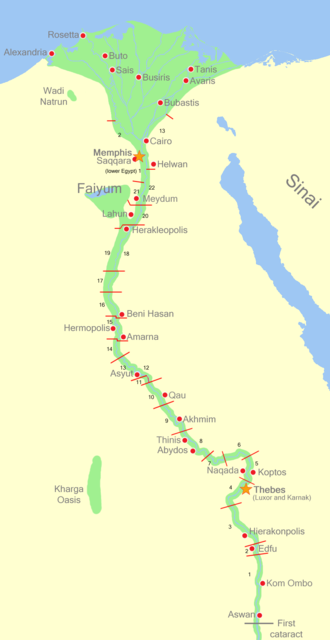Nome (Egypt)
A Nome (from Greek: Νομός, “district”) was an administrative part of ancient Egypt. Nome is a Greek name, used late in Egypt's history; the Egyptian name was "sepat".
The division of ancient Egypt into nomes happened before 3100 BC. These nomes began as autonomous city-states, but later began to join together. According to ancient tradition, the ruler Menes finally joined all the nomes into a single kingdom.[1]
The nomes remain in place for more than 3,000 years.
Lower Egypt, from the Old Kingdom capital Memphis to the Mediterranean Sea, had 20 nomes. The first was based around Memphis, Saqqara, and Giza, in the area occupied by modern-day Cairo. The nomes were numbered in a more or less orderly fashion south to north through the Nile delta. The numbering started in the west, and continued with the higher numbers in the east. Alexandria was in the Third Nome; Bubastis was in the Eighteenth.
Upper Egypt was divided into 22 nomes. The first of these was centered around Elephantine close to Egypt's border with Nubia at the First Cataract – the area of modern-day Aswan. From there the numbering progressed downriver in an orderly fashion along the narrow fertile strip of land that was the Nile valley. Waset (ancient Thebes or contemporary Luxor) was in the Fourth Nome, Amarna in the Fourteenth, and Meidum in the Twenty-First.
List of nomes
The nomes are listed in separate tables for Upper and Lower Egypt
Lower Egypt
| Number | Egyptian Name | Capital | Modern Capital | Translation |
|---|---|---|---|---|
| 1 | Aneb-Hetch | Ineb Hedj / Men-nefer / Menfe (Memphis) | Mit Rahina | White Walls |
| 2 | Khensu | Khem (Letopolis) | Ausim | Cow's thigh |
| 3 | Ament | Imu (Apis) | Kom el-Hisn | West |
| 4 | Sapi-Res | Ptkheka | Tanta | Southern shield |
| 5 | Sap-Meh | Zau (Sais) | Sa el-Hagar | Northern shield |
| 6 | Khaset | Khasu (Xois) | Sakha | Mountain bull |
| 7 | A-ment | (Hermopolis Parva, Metelis) | Damanhur | West harpoon |
| 8 | A-bt | Tjeku / Per-Atum (Heroonpolis, Pithom) | Tell al-Maskhuta | East harpoon |
| 9 | Ati | Djed (Busiris) | Abu Sir Bara | Andjeti |
| 10 | Ka-khem | Hut-hery-ib (Athribis) | Banha (Tell Atrib) | Black bull |
| 11 | Ka-heseb | Taremu (Leontopolis) | Tell al-Urydam | Heseb bull |
| 12 | Theb-ka | Tjebnutjer (Sebennytos) | Samanud | Calf and Cow |
| 13 | Heq-At | Iunu (Heliopolis) | Materiya (suburb of Cairo) | Prospering Sceptre |
| 14 | Khent-abt | Tjaru (Sile, Tanis) | Tell Abu Sefa | Eastmost |
| 15 | Tehut | Ba'h / Weprehwy (Hermopolis Parva) | Baqliya | Ibis |
| 16 | Kha | Djedet (Mendes) | Tell al-Rubˁ | Fish |
| 17 | Semabehdet | Semabehdet (Diospolis Inferior) | Tell el-Balamun | The throne |
| 18 | Am-Khent | Per-Bastet (Bubastis) | Tell Bastah (near Zagazig) | Prince of the South |
| 19 | Am-Pehu | Dja'net (Leontopolis Tanis) | Nebesha or San el-Hagar | Prince of the North |
| 20 | Sopdu | Per-Sopdu | Saft al-Henna | Plumed Falcon |
Upper Egypt
| Number | Egyptian Name | Capital | Modern Capital | Translation |
|---|---|---|---|---|
| 1 | Ta-Khentit | Abu / Yebu (Elephantine) | Aswan | The frontier or Land of the bow |
| 2 | Thes-Hor | Djeba (Apollonopolis Magna) | Edfu | Throne of Horus |
| 3 | Ten | Nekhen (Hierakonpolis) | al-Kab | Shrine |
| 4 | Waset | Niwt-rst / Waset (Thebes) | Luxor | Sceptre |
| 5 | Herui | Gebtu (Coptos) | Qift | The two falcons |
| 6 | Aa-ta | Lunet / Tantere (Tentyra) | Dendera | The crocodile |
| 7 | Seshesh | Seshesh (Diospolis Parva) | Hu | Sistrum |
| 8 | Abdju | Abdju (Abydos) | al-Birba | Great land |
| 9 | Min | Apu / Khen-min (Panopolis) | Akhmim | Min |
| 10 | Wadkhet | Djew-qa (Aphroditopolis) | Ifteh | Cobra |
| 11 | Set | Shashotep (Hypselis) | Shutb | The creature associated with Set |
| 12 | Tu-ph | Hut-Sekhem-Senusret (Antaeopolis) | Qaw al-Kebir | Viper mountain |
| 13 | Atef-Khent | Zawty (z3wj-tj, Lycopolis) | Asyut | Upper Sycamore and Viper |
| 14 | Atef-Pehu | Qesy (Cusae) | al-Qusiya | Lower Sycamore and Viper |
| 15 | Un | Khemenu (Hermopolis Magna) | al-Ashmunayn | Hare |
| 16 | Meh-Mahetch | Hebenu | Kom el Ahmar | Oryx |
| 17 | Anpu | Saka (Cynopolis) | al-Kais | Anubis |
| 18 | Sep | Teudjoi / Hutnesut (Alabastronopolis) | el-Hiba | Set |
| 19 | Uab | Per-Medjed (Oxyrhynchus) | el-Bahnasa | Two Sceptres |
| 20 | Atef-Khent | Henen-nesut (Herakleopolis Magna) | Ihnasiyyah al-Madinah | Southern Sycamore |
| 21 | Atef-Pehu | Shenakhen / Semenuhor (Crocodilopolis, Arsinoe) | Madinat al-Fayyum | Northern Sycamore |
| 22 | Maten | Tepihu (Aphroditopolis) | Atfih | Knife |
Nome (Egypt) Media
References
Alan K. Bowman (1990). Egypt After the Pharaohs. Oxford University Press.
- ↑ Herodotus, Euterpe, 2.4.1 and 2.99.1ff.
Other websites
- Details of the nomes
- Archaeological survey of the nomes Archived 2019-04-05 at the Wayback Machine





